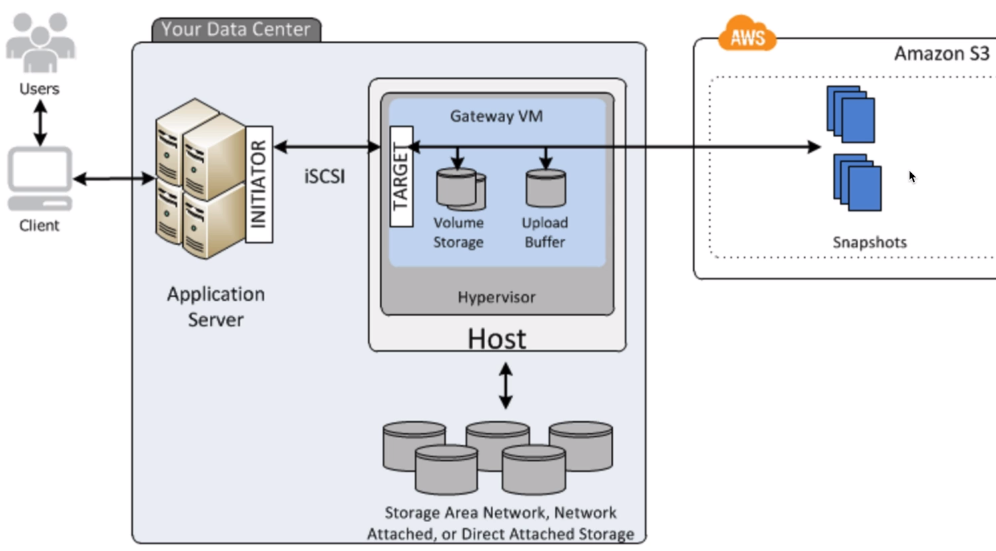What is Storage Gateway?
AWS Storage Gateway is a service that connects an on-premises software appliance with cloud-based storage to provide seamless and secure integration between an organization's on premises IT environments and AWS's storage infrastructure.
The service enables you to securely store data to the AWS cloud for scalable and cost-effective storage.
AWS Storage Gateway's software appliance is available for download as a virtual machine (VM) image that you install on a host in your datacenter.
Storage Gateway supports either VMware ESxi or Microsoft Hyper-V.
Once you've installed your gateway and associated it with your AWS account through the activation process, you can use the AWS Management Console to create the storage gateway option that is right for you.
Any migration project needs to consider how to manage legacy data and data formats.
This includes backup and archives.
A 3rd party archive service is viable, but would be an ongoing expense.
Storage Gateway can be used to efficiently move data into AWS.
Old tapes could either be restored to the Storage Gateway volume, or migrated to Virtual tapes inside AWS using Tape Gateway.
Three different types of Storage Gateway: - File Gateway (NFS & SMB) - Basically a way to store files in S3 - Volume Gateway (iSCSI) - Stored Volumes & Cached Volumes - Store copies of your hard disc drives or virtual hard disc drives - Tape Gateway (VTL) - Virtual Tape Library
File Gateway
Files are stored as objects in your S3 buckets, accessed through a Network File System (NFS) mount point. Ownership, permissions, and timestamps are durably stored in S3 in the user-metadata of the object associated with the file. Once objects are transferred to S3, they can be managed as native S3 objects, and bucket policies such as versioning, lifecycle management, and cross-region replication apply directly to objects stored in your bucket.Volume Gateway
The volume interface presents your applications with disk volumes using iSCSI block protocol. Data written to these volumes can be asynchronously backed up as point-in-time snapshots of your volumes, and stored in the cloud as Amazon EBS snapshots. Snapshots are incremented backups that capture only changed blocks. All snapshot storage is also compressed to minimize your storage charges. - Stored Volumes
Let you store your primary data locally, while asynchronously backing up that data to AWS. Stored volumes provide your on-premises applications with low-latency access to their entire datasets, while providing durable, off-site backups. You can create storage volumes and mount them as iSCSI devices from your on-premises application servers. Data written to your stored volumes is stored on your on-premises storage hardware. This data is asynchronously backed up to Amazon S3 in the form of Amazon EBS snapshots. 1GB - 16TB in size for Stored Volumes. - Cached Volumes Let you use Amazon S3 as your primary data storage while retaining frequently accessed data locally in your storage gateway. Cached volumes minimize the need to scale your on-premises storage infrastructure, while still providing your applications with low-latency access to their frequently accessed data. You can create storage volumes up to 32TiB in size and attach to them as iSCSI devices from your on-premises applicaton servers. Your gateway stores data that you write to these volumes in Amazon S3 and retains recently read data in your on-premises storage gateway's cache and upload buffer storage. 1GB to 32TB in size for Cached Volumes.Tape Gateway
Offers a durable, cost-effective solution to archive your data in the AWS Cloud. The VTL interface lets you leverage your existing tape-based backup application infrastructure to store data in virtual tape cartridges that you create on your tape gateway. Each tape gateway is preconfigured with a media changer and tape drives, which are available to your existing client backup applications as iSCSI devices. You add tape cartridges as you need to archive your data. Supported by NetBackup, Backup Exec, Veeam etc,


